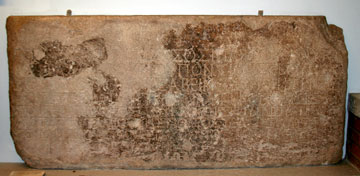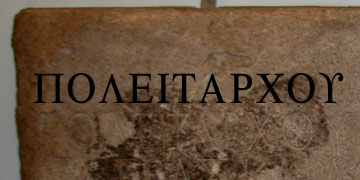The British Museum contains some of the greatest treasures of the world. Here you can view that actual Rosetta Stone. This amazing museum is filled with the finest remnants of the ancient world. If you visit the once-famous Temple of Artemis in Ephesus, for example, you’ll see only one lonely pillar, unadorned in the middle of a marsh. But in the British Museum you can examine up close a giant, beautifully carved section of a pillar that once belonged to the Temple of Artemis.
 In the midst of some of the finest works of classical art, I found something that 99% of visitors to the British Museum would overlook. For one thing, it was in basement, literally in a back corner, as far from the entrance to the museum and you can get. Moreover, my hidden treasure was not some magnificent sculpture, but simply a Greek inscription, worn away by the years. Nevertheless, when I saw it, my pulse quickened.
In the midst of some of the finest works of classical art, I found something that 99% of visitors to the British Museum would overlook. For one thing, it was in basement, literally in a back corner, as far from the entrance to the museum and you can get. Moreover, my hidden treasure was not some magnificent sculpture, but simply a Greek inscription, worn away by the years. Nevertheless, when I saw it, my pulse quickened.
Why? you wonder. Because it is an inscription of significance for those of us interested in the New Testament, and especially for those of us who believe that the Gospel writers were accurate historians. (As you probably know, I’ve recently written a book on this theme, Can We Trust the Gospels?)
 This inscription comes from the Macedonian city of Thessalonica. It was once part of a Roman gateway there, and was found after the gateway was demolished in 1876. The inscription, much of which I cannot read, mentions the “city rulers” of Thessalonica, using a term that was used in Macedonia, politarche in Greek. (In the close up to the right you can see the letters of this word, spelled an added epsilon. I added letters immediately above the ones carved into the stone.)
This inscription comes from the Macedonian city of Thessalonica. It was once part of a Roman gateway there, and was found after the gateway was demolished in 1876. The inscription, much of which I cannot read, mentions the “city rulers” of Thessalonica, using a term that was used in Macedonia, politarche in Greek. (In the close up to the right you can see the letters of this word, spelled an added epsilon. I added letters immediately above the ones carved into the stone.)
Why is this important for New Testament studies, and for the issue of the reliability of the Gospels? First, you need to know that the author of the Third Gospel, whom we call Luke, was also the author of Acts of the Apostles. Second, you need to know that Luke uses the term politarche in Acts 17, when he refers to the “city officials” of Thessalonica (vv. 6, 8). This is the only place Luke uses this particular term. This means that Luke not only knew the term politarche, but also that he was careful to use it only when it was appropriate. This is the sort of nuance that we would find only from a careful historian and writer.
Of course the fact that Luke uses politarche doesn’t prove that his gospel is historically accurate. We need more evidence than this to make such a case. But his use of politarche tells us something important about Luke’s ability as a researcher and it demonstrates the kind of care he exercised in his writing. One who used politarche correctly in Acts could be expected to exercise similar caution when writing about Jesus.
Thus, actually seeing one of the ancient inscriptions that uses the word politarche, I enjoyed an “a-ha” moment in some far away corner of the British Museum. The more we actually learn about the Roman world, the more we realize how much we can trust the New Testament in general, and the New Testament Gospels in particular.
More from Beliefnet and our partners

